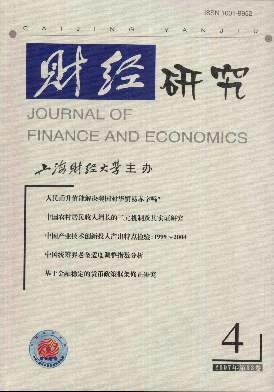我国金融排除空间差异的影响要素分析
财经研究 2007 年 第 33 卷第 04 期, 页码:108 - 120
摘要
参考文献
摘要
金融排除理论是一门新兴理论。文章介绍了金融排除的现状,并结合我国实际,尝试利用主成分分析、因子分析和聚类分析,建立排序选择模型,确定影响我国金融排除空间差异的影响要素,同时指出金融排除理论深化研究的思路和前景。
[1]Kempson E,Whyley C.Kept out or opted out?Understanding and combating financialexclusion[M].London:The Polity Press,Cambridge,1999.
[2]Kempson E,Whyley C,Caskey J,Collard S.In or out?[EB].Financial Exclusion:ALiterature and Research Review,Financial Services Authority,London,2000.http://www.fsa.gov.uk/pubs/consumer-research/crpr03.pdf.
[4]Leyshon A,Thrift N.Inside/outside:Geographies of financial inclusion and exclusion in Brit-ain[EB].1997.http://www.gego.not-tingham.ac.uk/~Leyshon/insideoutside.pdf.
[5]Leyshon A,Thrift N.Financial exclusion and the shifting boundaries of the financialsystem[J].Environment and Planning,1996,28:1150~1156.
[6]Jenny Rossiter.Financial exclusion:Can mutuality fill the gap?[EB].Seminar organisedby the New Policy Institute and the UK Social Investment Forum,1997,(6).http://www.npi.org.uk/reports/mutuality.pdf.
[8]Leyshon A,Thrift N.Financial desertification[A].Rossiter J.Financial exclusion:Canmutuality fill the gap?[C].London:New Policy Institute,1997:7~11.
[9]Mayo E.Policy responses to financial exclusion[A].Rossiter J.Financial exclusion:Can mutuality fill the gap?[C].London:New Policy Institute,1997:12~15.
[10]Reifner U.New financial products for inclusive banking[A].Rossiter J.Financial ex-clusion:Can mutuality fill the gap?[C].London:New Policy Institute,1997:16~21.
[11]Rossiter J,Kenway P.Introduction[A].Rossiter J.Financial exclusion:Can mutual-ity fill the gap?[C].London:New Policy Institute,1997:3~6.
[12]Conaty P.New mutuality in practice:The example of art[A].Rossiter J.Financial exclu-sion:Can mutuality fill the gap?[C].London:New Policy Institute,1997:22~26.
[13]Newcombe R.Social banking:The example of new horizons[A].Rossiter J.Financial exclu-sion:Can mutuality fill the gap?[C].London:New Policy Institute,1997:27~30.
[14]UNDP.National desertificaton funds:An information note prepared in the context ofthe United Nations convention to combat desertification[EB].1996.http://www.undp.org/seed/unso/borceng.htm.
[15]Howell N.Financial exclusion and microfinance:An overview of the issues[A].Pres-ented to QCOSS seminar opportunity knocks:Microfinance as a pathway to financial andsocial exclusion[C].Brisbane,2005,(27).http://www.griffith.edu.au/centre/cccl/pubs/fnex0605.pdf.
[16]Collard,Kempson,Whyley.Tackling financial exclusion:An area-based approach[EB].1999.http://www.pfrc.bris.ac.uk/Reports/Tackling_financial_exclusion.pdf.
[17]HM Treasury.Promoting financial inclusion[EB].2004,(12).http://www.hm-treasury.gov.uk/media/8F9/37/pdr04 profininc complete 394.pdf.
[18]Burchardt T,Hills J.Financial services and social exclusion[J].Insurance Trends,1998,7:1~10.
[19]李小建,周雄飞,卫春江,等.发展中地区银行业空间系统变化——以河南省为例[J].地理学报,2006,(4):414~424.
[20]武巍,刘卫东,刘毅.西方金融地理学研究进展及其启示[J].地理科学进展,2005,(4):19~27.
[21]田霖.企业家甄别、民间金融与金融共生[J].重庆大学学报,2005,(5):35~37.
[22]田霖.区域金融成长差异:金融地理学视角[M].北京:经济科学出版社,2006.
[23]伍海华.金融区域二元结构及发展对策[J].经济理论与经济管理,2002,(8):22~27.
[24]赵晓英.区域投资与经济增长[M].北京:中国金融出版社,2003.
[2]Kempson E,Whyley C,Caskey J,Collard S.In or out?[EB].Financial Exclusion:ALiterature and Research Review,Financial Services Authority,London,2000.http://www.fsa.gov.uk/pubs/consumer-research/crpr03.pdf.
[4]Leyshon A,Thrift N.Inside/outside:Geographies of financial inclusion and exclusion in Brit-ain[EB].1997.http://www.gego.not-tingham.ac.uk/~Leyshon/insideoutside.pdf.
[5]Leyshon A,Thrift N.Financial exclusion and the shifting boundaries of the financialsystem[J].Environment and Planning,1996,28:1150~1156.
[6]Jenny Rossiter.Financial exclusion:Can mutuality fill the gap?[EB].Seminar organisedby the New Policy Institute and the UK Social Investment Forum,1997,(6).http://www.npi.org.uk/reports/mutuality.pdf.
[8]Leyshon A,Thrift N.Financial desertification[A].Rossiter J.Financial exclusion:Canmutuality fill the gap?[C].London:New Policy Institute,1997:7~11.
[9]Mayo E.Policy responses to financial exclusion[A].Rossiter J.Financial exclusion:Can mutuality fill the gap?[C].London:New Policy Institute,1997:12~15.
[10]Reifner U.New financial products for inclusive banking[A].Rossiter J.Financial ex-clusion:Can mutuality fill the gap?[C].London:New Policy Institute,1997:16~21.
[11]Rossiter J,Kenway P.Introduction[A].Rossiter J.Financial exclusion:Can mutual-ity fill the gap?[C].London:New Policy Institute,1997:3~6.
[12]Conaty P.New mutuality in practice:The example of art[A].Rossiter J.Financial exclu-sion:Can mutuality fill the gap?[C].London:New Policy Institute,1997:22~26.
[13]Newcombe R.Social banking:The example of new horizons[A].Rossiter J.Financial exclu-sion:Can mutuality fill the gap?[C].London:New Policy Institute,1997:27~30.
[14]UNDP.National desertificaton funds:An information note prepared in the context ofthe United Nations convention to combat desertification[EB].1996.http://www.undp.org/seed/unso/borceng.htm.
[15]Howell N.Financial exclusion and microfinance:An overview of the issues[A].Pres-ented to QCOSS seminar opportunity knocks:Microfinance as a pathway to financial andsocial exclusion[C].Brisbane,2005,(27).http://www.griffith.edu.au/centre/cccl/pubs/fnex0605.pdf.
[16]Collard,Kempson,Whyley.Tackling financial exclusion:An area-based approach[EB].1999.http://www.pfrc.bris.ac.uk/Reports/Tackling_financial_exclusion.pdf.
[17]HM Treasury.Promoting financial inclusion[EB].2004,(12).http://www.hm-treasury.gov.uk/media/8F9/37/pdr04 profininc complete 394.pdf.
[18]Burchardt T,Hills J.Financial services and social exclusion[J].Insurance Trends,1998,7:1~10.
[19]李小建,周雄飞,卫春江,等.发展中地区银行业空间系统变化——以河南省为例[J].地理学报,2006,(4):414~424.
[20]武巍,刘卫东,刘毅.西方金融地理学研究进展及其启示[J].地理科学进展,2005,(4):19~27.
[21]田霖.企业家甄别、民间金融与金融共生[J].重庆大学学报,2005,(5):35~37.
[22]田霖.区域金融成长差异:金融地理学视角[M].北京:经济科学出版社,2006.
[23]伍海华.金融区域二元结构及发展对策[J].经济理论与经济管理,2002,(8):22~27.
[24]赵晓英.区域投资与经济增长[M].北京:中国金融出版社,2003.
引用本文
田霖. 我国金融排除空间差异的影响要素分析[J]. 财经研究, 2007, 33(4): 108–120.
导出参考文献,格式为:





 6181
6181  957
957

